Beijing
This was it - our final destination in the PRC. 5 days to cram as much Chinese culture and sightseeing in as possible before leaving the country.
As we were booked in to a private guesthouse east of the Forbidden City, but not sure quite where, it was easier taking a taxi directly there. The taxi driver stopped a few times to enquire about its exact location and then deposited us in an alleyway outside a small green door set in a red surround and topped by a tiny tiled roof.
 |
| Entry to Cong's hutong |
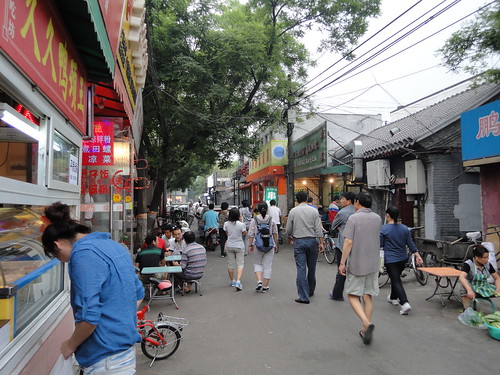 |
| LiShi Hutong - the alleyway to Cong's place |
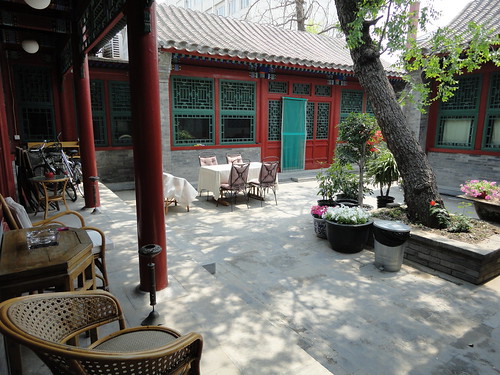 |
| Cong's courtyard |
 |
| Our sitting room |
My internet search as we travelled through China had me returning longingly to Cong's Hutong website and its photos of 4 exquisitely decorated rooms. The reality didn’t disappoint. Hongbin Cong, the owner, and his wife May extended us such warm hospitality in their courtyard home, produced a map and pointed out areas of interest that we may wish to explore. Our room was full of charm - handpainted wall mural, Chinese slippers and traditional-styled furniture - and had the biggest shower stall that we’d encountered in our time in China, with a brilliant rainshower. Their quiet, self-composed ‘ai’ (maid) prepared us lovely breakfasts served alfresco in the sunny courtyard. Whilst outside the walls of this courtyard home was the noise of traffic and people, in here all we heard were the sounds of birds.
Fine warm weather greeted us on our first day and gave us enough time to walk the long distance to collect our Trans-Mongolian train tickets, eat a cheap meal at the expansive Oriental Plaza shopping mall and pick up some supplies, for our upcoming train trip, on the walk back before a sudden late afternoon thunderstorm cracked the skies open.
That evening we caught a taxi to the Dadong Peking Duck restaurant which Hongbin had recommended when we spoke about Beijing’s famous duck dish. It ranked as one of the outstanding memories of our stay in Beijing. This was a swanky establishment decked out in glass, black granite and gleaming steel. The chef is renowned for creating a crispy, less fatty version of this dish. With gin and tonic in hand, we watched from behind a glass display window the numerous chefs in white aprons & high chefs’ hats briskly whizzing around the kitchen serving and checking all the ducks hanging in brick roasting ovens with open fires.
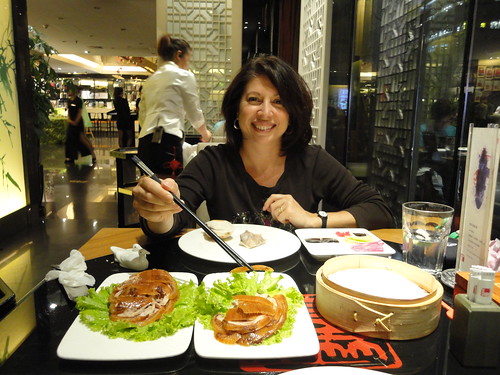 |
| Duck a la Peking style |
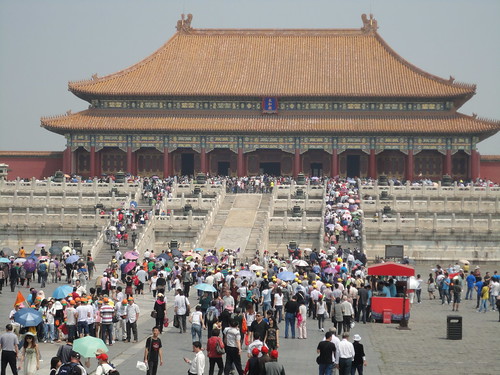 |
| The mighty Forbidden City |
The Forbidden City and Tiananmen Square were next on our hit list and we tackled this mammoth task with great gusto. Eight hours of it - pounding the pavements from one end of the Forbidden City to the other, around the vast perimeter of Tiananmen Square and partly by foot and by bus up to the hillside Jingshan Park for a panoramic overview of the Forbidden City.
Superlatives and words cannot describe the splendour, majesty and enormous scale of the ancient walled home of China’s many emperors. Entry upon invitation, otherwise executed was the rule of the times. Nowadays, the torture one faces is the hordes of tourists pushing past and blocking views to see exactly what you are hoping to capture on camera. The complex houses a huge number of halls, gated entries, temples, royal jewellery, royal residences and palaces. They have beautiful names such as Gate of Supreme Harmony, Hall of Mental Cultivation, Hall of Preserving Harmony, Palace of Heavenly Purity and Earthly Tranquility Palace. Don’t you just love the gracefulness of it all.
 |
| Palace grounds at Forbidden City |
The return back to our accommodation at the end of such an enormous day out was a challenge. After half an hour of unsuccessfully hailing a taxi, a short walk, followed by a 20 minute ride standing squished up in a crowded local bus that managed to crawl about a kilometre through traffic, we gave up, descended from the bus and walked the remaining distance to the nearest metro. There in the metro station we queued up and joined the throngs of people sardined into each carriage before it spewed us out near our destination – an ordeal of 2 hours duration. Welcome to Beijing at peak hour. An added delay upon entering Beijing’s metros each time is that all bags must go through x-ray machines. It was certainly a huge relief to return to the serene sanctuary of our room after an exhausting day in the hustle and bustle of such a BIG city.
Whilst wandering through some of the touristy hutongs lined with cafes, bars, accommodation places, souvenirs and craft shops, we came across a hostel which drew us inside and had us booking a tour to the Great Wall. Hongbin had described the many sections of wall and their level of difficulty so we knew which part we wanted to climb, and this hostel was offering just the right tour.
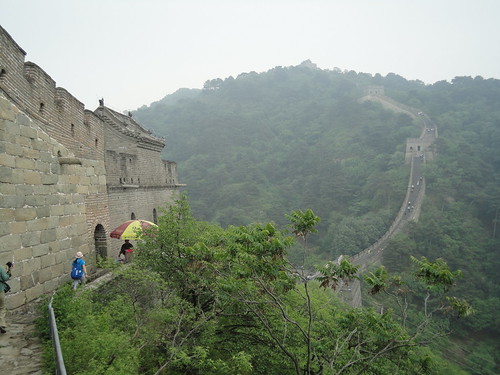 |
| Watch towers at Mutianyu section of Great Wall |
Boy, they bred them tough in those days – not only to have hauled these massive building blocks up such steep slopes and erect the walls on the crests of the heavily forested hills, but to then stand guard in the isolation of these watchtowers, like eagles in their nests through heat and snow. Nowadays, the landscape is filled with a huge array of fruit trees that grow in the area.
 |
| Hang on! |
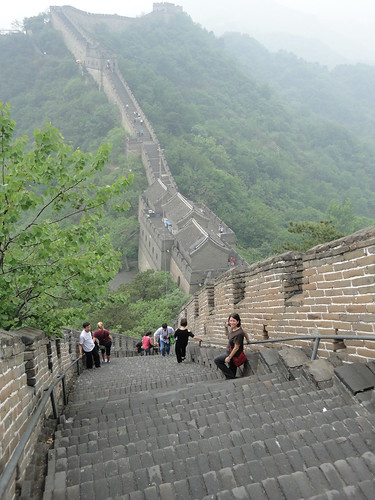 |
| A long way down |
We had seen enough pagodas, museums, temples and drum and bell towers in other parts of China so we skipped Beijing’s long list of them and chose to make our own way out to the Summer Palace, about 12 km out of the city. This was where royalty would escape to during the summer heat in the Forbidden City. Our plan was to metro it part of the way and then take a boat ride along the canal for the remainder.
It was a fairly long metro ride to our jumping off point. As usual, Max referred to his compass when exiting the metro station to ensure we were heading in the right direction, then it was a 15 minute walk to the Beijing Exhibition Centre where boats were apparently moored behind the building. We mistakenly thought we’d have to enter through the Exhibition Centre which was crowded with mostly young people queuing up to purchase entry tickets. Max lined up and purchased us tickets, coming away laughing. “I’ve just bought us tickets to a wedding expo” he explained. Okay, this was not on our agenda so Max gave them away to a passing couple and we eventually found the way to the canal boats (not signposted).As the only 2 foreigners in a boat depicting a huge dragon’s head at the bow, we slowly floated along past the Beijing Zoo, the Aquarium, under little bridges and finally near the edge of the Palace’s huge Kunming Lake – sailing for about an hour and a half. To reach the palace was about a kilometre’s walk, then a ferry ride across to the opposite side of the lake. Each ferry was styled to look like a dragon carrying passengers in a temple on its back. All up about half a day’s travelling needed to finally reach our destination. By that stage, hunger had set in so sightseeing was pushed aside for more important matters of the stomach.
The Summer Palace, set on a hill, is on a huge estate that stretches for miles with lakes, temples, pagodas, pretty bridges, long boardwalks with elaborate paintings and a reproduction of a mini canal town. As lovely as it was, after our time in China it was, however, beginning to all look more of the same. What was even more daunting was that we did not relish the long, tiring metro ride back.
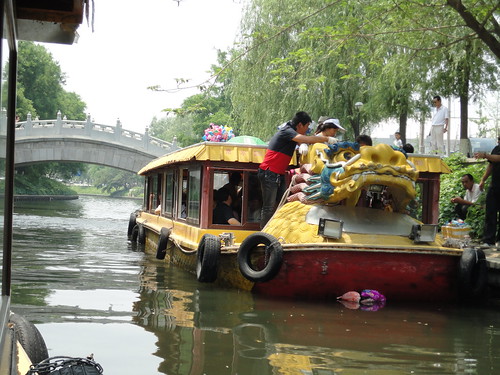 |
| Beijing canal boat |
 |
| Summer Palace estate |
Our final evening in Beijing had us seeking out Snack Alley. In this alley was a small set of roadside stalls set up with foods from the exotic to the bizarre such as toffeed tropical fruits to snake meat, skewered silkworm pupae, centipedes, seahorses, honey bees, sheep testicles, locusts and scorpions. It did have a bit of a touristy, contrived kind of feel to it, but we watched in abhorrent surprise at how some of the Asian tourists were prepared to sample the creepy crawlies.
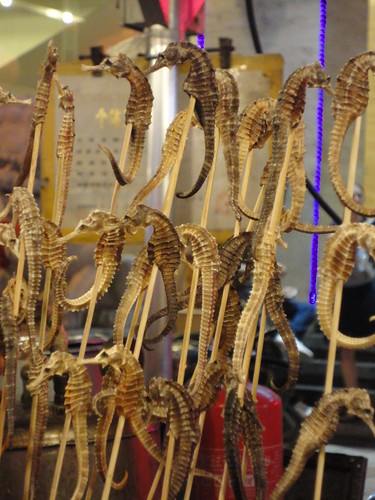 |
| Snack Alley |
But Beijing is great in lots of different ways – not only by the sheer size of its city, landmarks and population but by its fascinating history and traditions. And let’s not forget the shopping. A visit to Silk Market, a complex of 5 floors of shopaholics’ paradise, and others like it, made me wish that we were at the end of our trip and not the start. I could have gone crazy with the huge array of handbags, clothing and shoes, but restrained myself to 3 silk scarves and 1 pashmina that are weightless and fit nicely into a backpack.
A big thank you to Hongbin for his help and late-night phone calls in regards to our rail tickets and for making our stay one of the best highlights of Beijing.
Xiexie, Zhongguo for the memories. (Thank you, China)



 Hi, I'm Eva - world traveller, cultural explorer and experience seeker. Together with my husband Max, we've been globetrotting for over 20 years.
Hi, I'm Eva - world traveller, cultural explorer and experience seeker. Together with my husband Max, we've been globetrotting for over 20 years.







0 comments: